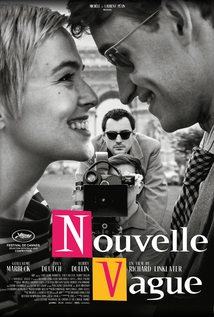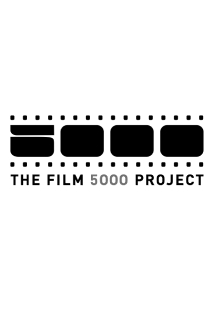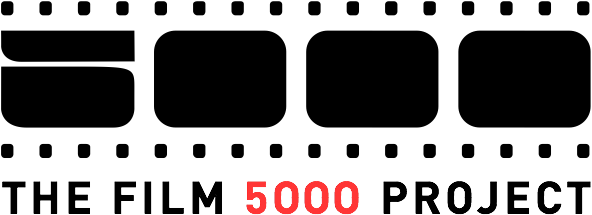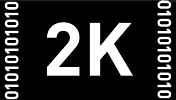

The second film of Richard Linklater's 2025 one-two punch of portrait-of-an-artist-and-an-era-period-pieces (actually, they're more of a kiss-kiss than a punch-punch) offers the flip side to his Blue Moon, which was released in America just a couple of weeks prior. Whereas Blue Moon imagines a fictional night at Sardie's, in which the legendary American lyricist Lorenz Hart, at the sad end of his career, attempts to celebrate what he considers the mediocrity of his former writing partner Richard Rodgers' Broadway-musical-redefining hit, Oklahoma!, Nouvelle Vague meticulously recreates the well-documented month in which the French enfant terrible, Jean-Luc Godard, at the beginning of his career, shot the cinema-redefining landmark of the French New Wave, Breathless. The two characters at the center of this picture could not be more different in terms of their stages of life, but both have colossal egos that dwarf those of mere mortals.
Of the two movies, Blue Moon is vastly superior (it's actually about something), but Nouvelle Vague is more fun. The latter film does little more than revel in the joy of recreating a behind-the-scenes glimpse of how the influential film critic-turned-upstart filmmaker shot all the memorable sequences in his soon-to-be-iconic experimental picture. It also presents us with a gallery of lookalikes for nearly everyone who was part of the Cahiers du Cinéma crowd and the few French filmmakers they respected. The casting is superb. I have no idea who Guillaume Marbeck is, but his young Jean-Luc Godard impression is uncanny. He's somehow able to convey an impish gleam in eyes you can't see because they're always behind sunglasses. That's a pretty neat trick, accomplished by the way he holds his mouth and delivers line after line culled from a lifetime of Godardisms, as if the outspoken filmmaker coined them all that month.
Even harder to find than a little wiry guy who looks and sounds like Jean-Luc Godard is someone who can embody Jean-Paul Belmondo, one of the most distinctive-looking actors in cinema history. But Aubry Dullin (another actor I've never heard of) does it very well. As Belmondo's Breathless co-star, the young American up-and-comer Jean Seberg, Zoey Deutch isn't quite a spitting image of her real-life character. In fact, from the brief glimpses I'd seen before the film's release, I didn't think the pretty daughter of Lea Thompson and Howard Deutch (whom most of us first saw in Linklater's 2016 college baseball comedy, Everybody Wants Some!!) was going to work at all—but in context, Deutch is just great. Seberg is depicted as the Breathless participant with the least faith in the process and the project. Still, nearly everyone involved in making the movie, including the original writer, François Truffaut (Adrien Rouyard), the producer, Georges de Beauregard (Bruno Dreyfürst), and the cinematographer, Raoul Coutard (Matthieu Penchinat), is more than dubious about Godard's unique approach to filmmaking.
Richard Linklater may seem an even odder choice as director for this movie than for Blue Moon. (I mean, can he even speak French?). Yet, there are thematic aspects to both stories that make him feel like the ideal person to have at the helm. He and Ethan Hawke have been working together for 30 years, since their 1995 brief-encounter picture Before Sunrise, which became a trilogy that, like many other Linklater films, serves as a meditation on the passage of time. It only seems fitting that these two men (one age 55 and the other 65) would relate to one of the great American artists nearing the end of his career and looking back at his past. Hart doesn't know at the time Blue Moon is sent that he will be dead at age 48, but he's too honest about himself not to have an inkling that the end is near. As for Nouvelle Vague, what living American director more than Linklater ignited a movement in cinema as profoundly as Jean-Luc Godard did in France? It is not at all difficult to imagine a film being made in 2055 about Linklater and his small crew wandering around Austin, Texas, shooting his industry-changing indie film, Slacker—with actors playing Steven Soderbergh, Kevin Smith, Quentin Tarantino, Michael Moore, Rose Troche, Guinevere Turner, Harvey Weinstein, John Pierson, and others in scenes at the Sundance Film Fest.
The question one must confront with Nouvelle Vague is, do you really get anything from it that you don't get by simply watching Breathless? Breathless is a movie that you watch with a heightened awareness of how it was made and what its director is doing. The more you know about Godard and the French New Wave, the more this movie feels like cosplay—a bunch of actors recreating famous anecdotes that many of us know by heart. But while you can sense the mischiefous pleasure Godard takes in each hand-held shot and jump-cut in Breathless, there is something to be said for actually seeing someone as perfectly cast as Marbeck embodying this sensation. For that reason, this movie offers pleasures that, while they certainly won't be there for everyone, will tickle most film buffs in places few movies have before.
Guillaume Marbeck's ability to convey an impish gleam in the eyes of Jean-Luc Godard, even though they're always behind sunglasses, makes Richard Linklater's reverential cosplay about the French enfant terrible shooing his industry-changing feature a worthy supplement to the pleasures of simply watching Breathless again.




